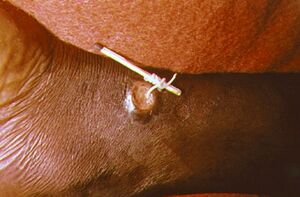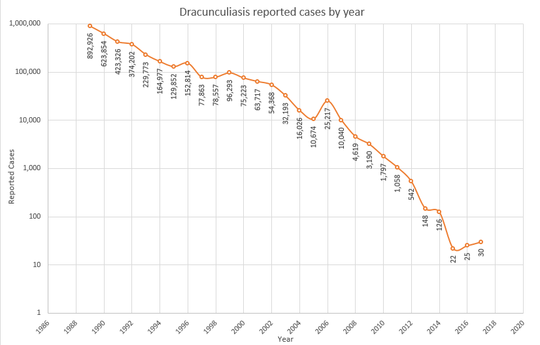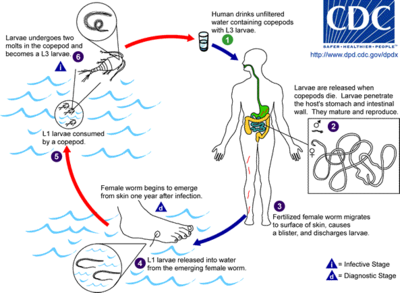داء التنينات
| Dracunculiasis | |
|---|---|
| الأسماء الأخرى | Guinea-worm disease (GWD) |
 | |
| Using a matchstick to wind up and remove a guinea worm from the leg of a human | |
| التخصص | Infectious disease |
| الأعراض | Painful blister on lower leg[1] |
| البداية المعتادة | Average time of one year after exposure[1] |
| المسببات | Guinea worms spread by water fleas[1] |
| الطريقة التشخيصية | Based on symptom[2] |
| الوقاية | Preventing those infected from putting the wound in drinking water, treating contaminated water[1] |
| العلاج | Supportive care[1] |
| التردد | 28 reported cases (2018)[1] |
| الوفيات | Rare |
داء التنينات إنگليزية: Dracunculiasis ويعرف أكثر بداء دودة غينيا (GWD) هي عدوى طفيلية تسببها الأسطوانية التنينة المدينية. تعتبر دودة غينيا من بين أكثر طفيليات الاٍنسان دراسة.
المسببات
الوبائيات
الوضع الحالي
البلدات المتوطنة
At the end of 2015, South Sudan, Mali, Ethiopia and Chad still had endemic transmissions. For many years the major focus was South Sudan (independent after 2011, formerly the southern region of Sudan), which reported 76% of all cases in 2013.[3] In 2017 only Chad and Ethiopia had cases.[4]
| Date | South Sudan | Mali | Ethiopia | Chad | Total |
|---|---|---|---|---|---|

|

|

|

|
||
| 2011 | 1,028[5] | 12[5] | 8[5] | 10[5] | 1058 |
| 2012 | 521[5] | 7[5] | 4[5] | 10[5] | 542 |
| 2013 | 113[5] | 11[5] | 7[5] | 14[5] | 148 (including 3 exported to Sudan) |
| 2014 | 70[5] | 40[5] | 3[5] | 13[5] | 126 |
| 2015 | 5[5] | 5[5] | 3[5] | 9[5] | 22 |
| 2016 | 6[5] | 0[5] | 3[5] | 16[5] | 25 |
| 2017 | 0[6] | 0[6] | 15[6] | 15[6] | 30 |
| 2018 | 10[7] | 0[7] | 0[7] | 17[7] | 28 (including one isolated case in Angola) |
| 2019 | 4[7] | 0[7] | 0[7] | 47[7] | 53 (including one isolated case in Angola and Cameroon) |
برنامج القضاء على المرض

التاريخ
Dracunculiasis has been a recognized disease for thousands of years:
- Guinea worm has been found in calcified Egyptian mummies.[9]
- An Old Testament description of "fiery serpents" may have been referring to Guinea worm: "And the Lord sent fiery serpents among the people, and they bit the people; and much people of Israel died." (Numbers 21:4–9).[10]
- In the 2nd century BC, the Greek writer Agatharchides described this affliction as being endemic amongst certain nomads in what is now Sudan and along the Red Sea.[11][10]
- In the 18th century, Swedish naturalist Carl Linnaeus identified D. medinensis in merchants who traded along the Gulf of Guinea (West African Coast).
- Guinea worms were described by Oliver Wendell Holmes Sr as "[burrowing] into the naked feet of West-Indian slaves..."[12]
It has been suggested that the Rod of Asclepius (a symbol that represents medical practice) represents a Guinea worm wrapped around a stick for extraction.[13] According to this thinking, physicians might have advertised this common service by posting a sign depicting a worm on a rod. However plausible, there is no concrete evidence in support of this notion.
The Russian scientist Alexei Pavlovich Fedchenko (1844–1873) during the 1860s while living in Samarkand was provided with a number of specimens of the worm by a local doctor which he kept in water. While examining the worms Fedchenko noted the presence of water fleas with embryos of the guinea worm within them.[14]
In modern times, the first to describe dracunculiasis and its pathogenesis was the Bulgarian physician Hristo Stambolski, during his exile in Yemen (1877–1878).[15] He correctly inferred that the cause was infected water which people were drinking.
أصل الاسم
Dracunculiasis once plagued a wide band of tropical countries in Africa and Asia. Its Latin name, Dracunculus medinensis ("little dragon from Medina"), derives from its one-time high incidence in the city of Medina (in modern Saudi Arabia), and its common name, Guinea worm, is due to a similar past high incidence along the Guinea coast of West Africa;[10] Guinea worm is no longer endemic in either location.[16]
معرض الصور
- Guinea worm prevention.jpg
أطفال سودانيون يستخدمون أنابيب ترشيح لتفادي دودة غينيا
الهامش
- ^ أ ب ت ث ج ح خطأ استشهاد: وسم
<ref>غير صحيح؛ لا نص تم توفيره للمراجع المسماةWHO2014 - ^ خطأ استشهاد: وسم
<ref>غير صحيح؛ لا نص تم توفيره للمراجع المسماةGord2009 - ^ خطأ استشهاد: وسم
<ref>غير صحيح؛ لا نص تم توفيره للمراجع المسماةWrap226 - ^ Donald G. McNeil Jr. (22 March 2018). "South Sudan Halts Spread of Crippling Guinea Worms". The New York Times. Retrieved 15 July 2018.
- ^ أ ب ت ث ج ح خ د ذ ر ز س ش ص ض ط ظ ع غ ف ق ك ل م "Guinea Worm Disease: Case Countdown". Carter Center. Archived from the original on 2014-01-21.
- ^ أ ب ت ث خطأ استشهاد: وسم
<ref>غير صحيح؛ لا نص تم توفيره للمراجع المسماةcarter2018 - ^ أ ب ت ث ج ح خ د "Guinea Worm Disease: Case Countdown". Carter Center. Archived from the original on 2018-12-19.
- ^ "Number of Reported Cases of Guinea Worm Disease by Year: 1989–2017*" (PDF). Guinea Worm Eradication Program. Retrieved 2018-01-21.
- ^ خطأ استشهاد: وسم
<ref>غير صحيح؛ لا نص تم توفيره للمراجع المسماةGWEP2 - ^ أ ب ت خطأ استشهاد: وسم
<ref>غير صحيح؛ لا نص تم توفيره للمراجع المسماةTropMed - ^ Plutarch; Goodwin, William W., ed. (1871). "Symposiacs, Book VIII, Question 9, §. 3". Plutarch's Morals. Vol. vol. 3. Boston, Massachusetts, USA: Little, Brown, and Co. p. 430.
{{cite book}}:|first2=has generic name (help);|volume=has extra text (help)CS1 maint: multiple names: authors list (link) From p. 430: "Those that fell sick about the Red Sea, if we believe Agatharcides, besides other strange and unheard diseases, had little serpents in their legs and arms, which did eat their way out, but when touched shrunk in again, and raised intolerable inflammations in the muscles; … " - ^ Holmes, Oliver Wendell (1952). The Autocrat of the Breakfast Table (1858). London: J.M Dent & Sons Ltd. p. 180. ISBN 1406813176.
- ^ Emerson, John (27 July 2003). "Eradicating Guinea Worm Disease". Social Design Notes. Archived from the original on 30 June 2017. Retrieved 6 February 2017.
- ^ See:
- Fedchenko (Федченко), Alexei (Алексей) (1870). "О строении и размножении ришты (Filaria medinensis L.)" [On the structure and reproduction of the Guinea worm (Filaria medinensis L.)]. Известия Императорского Общества Любителей Естествознания, Антропологии и Этнографии [News of the Imperial Society of Devotees of Natural Science, Anthropology and Ethnography (Moscow)] (in الروسية). 8 (1): 71–82.
- English translation: Fedchenko, A. P. (1971). "Concerning the structure and reproduction of the guinea-worm (Filaria medinensis L.)". American Journal of Tropical Medicine and Hygiene. 20 (4): 511–523. doi:10.4269/ajtmh.1971.20.511.
- ^ Христо Стамболски: Автобиография, дневници и mспомени. (Autobiography of Hristo Stambolski. Sofia : Dŭržavna pečatnica, 1927–1931)
- ^ "Guinea Worm Infection (Dracunculiasis)". The Imaging of Tropical Diseases. International Society of Radiology. 2008. Archived from the original on November 29, 2009. Retrieved December 2, 2009.
وصلات خارجية
- "Guinea Worm Disease Eradication Program". Carter Center.
- Nicholas D. Kristof from the New York Times follows a young Sudanese boy with a Guinea Worm parasite infection who is quarantined for treatment as part of the Carter program
- Tropical Medicine Central Resource: "Guinea Worm Infection (Dracunculiasis)"
- World Health Organization on Dracunculiasis
| Classification | |
|---|---|
| External resources |
قالب:Diseases of poverty قالب:Eradication of infectious disease
- CS1 errors: generic name
- CS1 errors: extra text: volume
- CS1 الروسية-language sources (ru)
- الصفحات بخصائص غير محلولة
- Short description is different from Wikidata
- Articles containing إنگليزية-language text
- Pages using Lang-xx templates
- Articles with hatnote templates targeting a nonexistent page
- Infectious diseases with eradication efforts
- دواد
- Neglected tropical diseases
- Parasitic diseases
- Parasitic infestations, stings, and bites of the skin
- Rare diseases
- Rare infectious diseases
- Wikipedia medicine articles ready to translate
- Tropical diseases
- Waterborne diseases
- RTTID
- أمراض طفيلية


